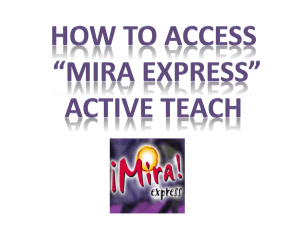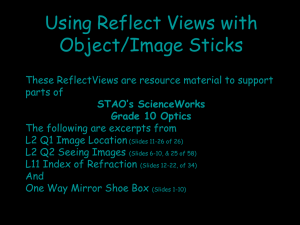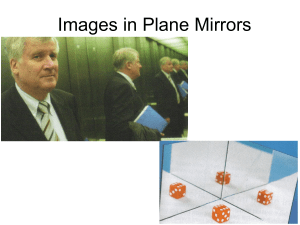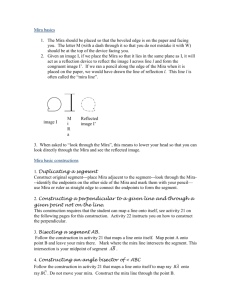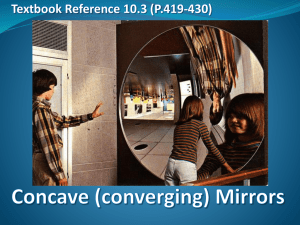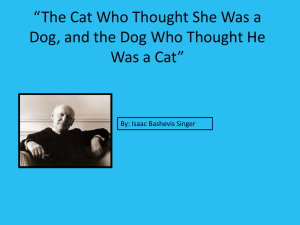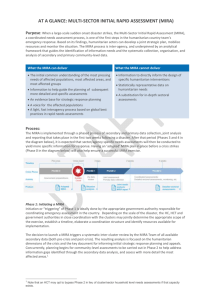Lesson 3 – MIRA Image Location Activity
advertisement
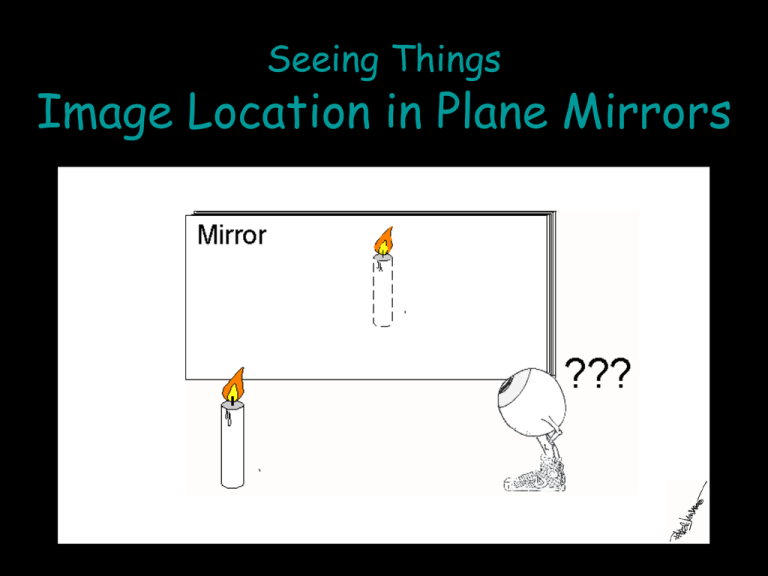
Seeing Things Image Location in Plane Mirrors We see the object when looking directly at it because rays of light go from it straight into our eyes. Experience has trained our Eye-Brain that things are located in the direction the light comes from. When we look in the mirror, we see an Image of the object. Experience has trained our Eye-Brain that things are located in the direction the light comes from. Rays of light must be coming straight from what we see in the mirror (the image) into our eyes. That is the way we see things. The image appears to be behind the mirror, but the light rays cannot come through the mirror. Mirrors are opaque. Two Questions 1) Where does the image appear to be located? 2) How can the light rays appear to go through an opaque mirror? Question 1) Where does the image appear to be located in a plane mirror? Image Location Lab Image Location Lab 1) Place an object in front of the MIRA on a sheet of scrap paper. 2) Notice that you can see a reflection of the object in the MIRA. If you use an Object/Image Stick, you even see the word Image in the reflection. 3) Place an Image locator (a second Object/Image Stick) behind the MIRA. 4) You can see the Image locator through the MIRA. If you use an Object/Image Stick, turn it around so that you can see the word Image through the MIRA. 5) Move the Image locator until it appears to overlap the image. 6) Trace the location of the object. 7) Trace the location of the mirror. 8) Trace the location of the image (Image locator). 9) Move the object twice (2X’s). 10) Trace all object and image locations. 11) Be careful to keep the MIRA in the same place. 12) You should have a piece of paper that looks similar to this. O1 O2 I2 O3 13) Draw a line from the centre of the object to the centre of the image so that you have a piece of paper that looks similar to this. O1 I3 O2 O3 14) What are two observations that can be used to predict the position of the image in a mirror? 15) Try the Bull’s Eye activity. I1 I2 I1 I3 Your Turn Do the Image Location Lab Image Location Lab Answers Follow 1) What are two observations that can be used to predict the position of the image in a mirror? a) The distance from the object to the mirror (dO). is the same as the distance from the image to the mirror (dI). Or dO=dI. b) The line connecting the object and image intersects the mirror at 90 °. 2) Use your observations to show where, and then describe how, you would place a MIRA or Reflect-View so that the tip of the arrow always appears to hit the Bull’s Eye. a) Draw a line connecting the Arrow Tip and the Bull’s Eye (object & image). 2) Use your observations to show where, and then describe how, you would place a MIRA or Reflect-View so that the tip of the arrow always appears to hit the Bull’s Eye. b) Place the mirror in the middle of the line dO=dI. 2) Use your observations to show where, and then describe how, you would place a MIRA or Reflect-View so that the tip of the arrow always appears to hit the Bull’s Eye. b) Place the mirror in the middle of the line and rotate it 90° to the line. 2) Use your observations to show where, and then describe how, you would place a MIRA or Reflect-View so that the tip of the arrow always appears to hit the Bull’s Eye.
